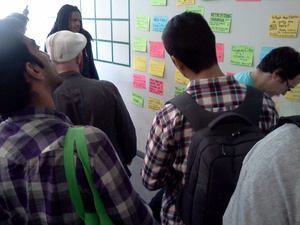 Hey look it's a bunch of people looking at sticky notes of sessions!Planning Camp 2013 is an unconference focused on the intersection between urban planning, technology, and social change. It took place on Oct. 12th at Laney College.
Hey look it's a bunch of people looking at sticky notes of sessions!Planning Camp 2013 is an unconference focused on the intersection between urban planning, technology, and social change. It took place on Oct. 12th at Laney College.
The official site is at http://planningcamp.org/ and you can see schedule details & lots of notes here: https://docs.google.com/document/d/1s0TSzyezM72mpYm4uGGqaBK6-R8KbOm9k5W9hRqaR2k/pub
Follow along on twitter with #plancamp.
Are you at Planning Camp? Add thoughts, ideas, reflections here:
Notes from Tech for Engagement:
Challenges in urban planning engaging with communities:
- Poor tools for people to create collaborative solutions out of many proposals. Easy to say "I don't like this" and "I don't like that," but difficult to actually have people collaborate to collaborate to come up with what they'd like to see.
- Difficult to know what people actually want, difficult for people to visualize changes proposed, and difficult for planners to communicate what they're planning: streetmix.net
- Difficult to translate technical terms and options in urban planning into "layspeak" to be able to get meaningful feedback from community members.
- Often the problem isn't lack of tools, but institutional unwillingness to be open with what they're doing and be meaningfully open to community engagement.
- Online engagement often draws the same group of people as in-person engagement - problems with inclusivity.
- For many in government, if you don't show up to the in-person meeting, you might as well not exist. Limits impact of other methods of engagement.
- Suggestion to institutionalize a "user research" phase in planning where planners research all the different ways that people want to and will engage with the planning process (give feedback and receive updates on what planners are doing).
- People who don't think they're interested in urban planning won't go to an urban planning site. Benefits of sites that offer broad information that people are interested in and what they're connected to.
- People don't see the sausage of how changes in the city happen. To them it seems to take forever, but they don't see the meetings and conversations that have to happen in order to make physical change in the infrastructure.
- It's up to planners to figure out the best way to engage with communities, regardless of what the barriers are.
Notes from combined session on "Engaging communities w/less access to technology and information" and "Platform for local community collaboration":
- It's not just language, but also computer literacy, digital literacy, internet literacy, and the entire milieu of different communities.
- Ex: in Fresno, planners had many potlucks and did purely-visual communication (post-it notes, etc.)
- Engage with the ways that people get their information (ex: Oakland Chinatown, folks are elderly and often don't speak/read English. They have strong community ties between each other and get a lot of info from the Chinese-language newspaper).
- In some instances, people collaborate & organize when people are threatened/in crisis.
-
How to get government to move beyond the in-person community input meeting to taking tech-enabled community input seriously?
- Once cities start to realize that they are getting valuable feedback from these other places, they will start to take them seriously.
- Creating physical space for people to participate. Cities have limited resources. Cities don't always have equity as an interest.
- Poetry slam of people's ideas for government at the neighborhood level, etc.



